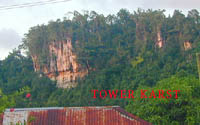KARST landscapes consist of limestone areas that have been sculpted by a combination of erosion and chemical dissolution to form dramatic topographies such as that typified by the Cockpit Country.
Much of the pioneering work in karst began in
Yugoslavia. In fact, the term "karst" comes from the Slav word,
"krs," and is associated with the limestone country in western
Slovenia. Other terminology, such as
doline, uvala, and polje, also originated here (Jennings,
1971).
GEOMORPHOLOGY On Jamaica, the karstification of the White and Yellow Limestone
Groups, which vary considerably in quality (e.g., purity, hardness)
and depth, has resulted in a landscape varying from gently rolling,
soil-covered plains through rough and jumbled deep depressions... (White 1988).
Erosion of the limestone has created a dramatic topography of rounded peaks and steep-sided, star-shaped, depressions known as .Cockpit
karst.
Cockpits are distinct from dolines in being deeper and not being circular in plan. On a contour map of a doline area [e.g. Dry Harbour Mountains], circular contour lines indicate the locations of negative relief elements (depressions), whereas on a contour map of cockpit karst terrain it is the positive relief features (the conical hills) that are shown by circular contour lines. (Lyew-Ayee, P., H. A. Viles, and G.E. Tucker. 2007. The use of GIS-based digital morphometric techniques in the study of cockpit karst Earth Surface Processes and Landforms. Vol. 32, pp 165-179). The hilltops and slopes
are marked by a distinctively minimal clay soil and organic humus
while the talus have retained soil coverage.  Cockpits average in depth
from 100 - 120m and walls generally slope from 30 - 40deg. Drainage
of the cockpit bottoms occurs via percolation or by sinkhole.
Drainage by the latter creates a complex, subterranean cellular
network. The periphery of Cockpit Country is marked by 'degraded'
cockpits, glades and valleys (poljes), such as seen in the Windsor, Pantrepant, and Fontabelle areas, terminating to the west in
the Queen of Spain's Valley, the best known and largest polje in
Jamaica. "Tower" karst (steep, near vertical sides) is found to the
north in the Duanvale Fault zone as well as in the southeast
region.
Cockpits average in depth
from 100 - 120m and walls generally slope from 30 - 40deg. Drainage
of the cockpit bottoms occurs via percolation or by sinkhole.
Drainage by the latter creates a complex, subterranean cellular
network. The periphery of Cockpit Country is marked by 'degraded'
cockpits, glades and valleys (poljes), such as seen in the Windsor, Pantrepant, and Fontabelle areas, terminating to the west in
the Queen of Spain's Valley, the best known and largest polje in
Jamaica. "Tower" karst (steep, near vertical sides) is found to the
north in the Duanvale Fault zone as well as in the southeast
region.